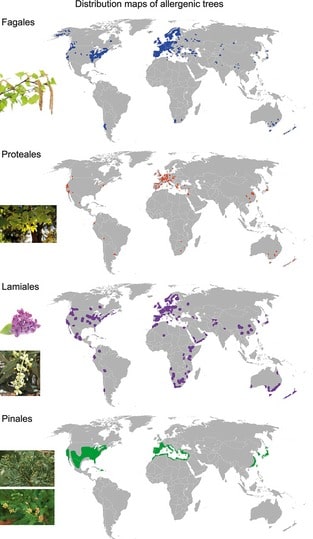On All Orders Within The Contiguous U.S.
On All Orders Within The Contiguous U.S.
 After making it this far through Covid-19 pandemic, don't let your guard down in 2022 when it comes to your allergies! The beginning of spring can be a time of awakening and a much welcomed reprieve from the cold and gloomy winter weather. However, for many of us, springtime also means the beginning of allergy season. For those that suffer from pollen allergies, the effects can start to appear as early as January in the southern US states while those in the north won't feel it until until May or June. Trees are the earliest producers of pollen and trigger the first onset allergy symptoms in those that have a sensitivity to pollen. In fact, the pollen count is currently so elevated in some areas of the United States that people without a known allergy to tree pollen can feel some allergy symptoms.
After making it this far through Covid-19 pandemic, don't let your guard down in 2022 when it comes to your allergies! The beginning of spring can be a time of awakening and a much welcomed reprieve from the cold and gloomy winter weather. However, for many of us, springtime also means the beginning of allergy season. For those that suffer from pollen allergies, the effects can start to appear as early as January in the southern US states while those in the north won't feel it until until May or June. Trees are the earliest producers of pollen and trigger the first onset allergy symptoms in those that have a sensitivity to pollen. In fact, the pollen count is currently so elevated in some areas of the United States that people without a known allergy to tree pollen can feel some allergy symptoms.
As seen on the map below, tree pollen season rolls out as early as January in the southern states and lasts into June. This season begins starting a little later as you move north up the map. The best region for those with tree pollen allergies is in the northern states as tree pollen is usually only active for about 4 months out of the year. In the southern states, it gets warmer earlier in the year and tree pollen can be in full force for six whole months.

Pollen allergens are viewed as a significant health factor responsible for allergic rhinitis and asthma, so there have been and continue to be numerous in-depth studies regarding this subject. Allergenic trees can basically be divided into four orders that have been determined to be the most potent sources: Fagales, Lamiales, Proteales, and Pinales. There is a pattern of geographical distribution for each order and allergenic trees are found in almost every part of the world. Below is an outline of the basic details of each order of allergenic tree and the typical location of each within the United States.
 Geographic distribution of allergenic Fagales, Lamiales, Proteales, and Pinales species. The distribution data were extracted from maps provided on www.eol.org. Photographs of florescences of members of the Fagales (birch Betula verrucosa), Proteales (plane tree Platanus acerifolia), Lamiales (lilac Syringa vulgaris and olive Olea europaea), and Pinales (mountain cedar Juniperus ashei and Japanese cedar Cryptomeria japonica) were obtained from Fotolia.
Geographic distribution of allergenic Fagales, Lamiales, Proteales, and Pinales species. The distribution data were extracted from maps provided on www.eol.org. Photographs of florescences of members of the Fagales (birch Betula verrucosa), Proteales (plane tree Platanus acerifolia), Lamiales (lilac Syringa vulgaris and olive Olea europaea), and Pinales (mountain cedar Juniperus ashei and Japanese cedar Cryptomeria japonica) were obtained from Fotolia.
You probably have a tree pollen allergy if you find yourself sneezing and sniffling at the start of spring, or even earlier if you in the southern US states. Many times, the symptoms of a pollen allergy are referred to as hay fever. These symptoms include:
The Asthma and Allergy Foundation of America recommends the following treatments:
No matter which type of HVAC system your home has, every unit needs a quality air filter that fits properly in order to maximize your indoor air quality and keep your unit running efficiently. US Home Filter can provide you with the best and most efficient HVAC filter available! Changing the filter in your furnace is as important as changing the oil in your car and US Home Filter offers filters to fit all heating and air conditioning units. From standard to custom air filters, to whole-house filters, grille filters, and humidifier filters, we have all of your filter needs covered!
Selecting the filters that are just right for your home can be difficult and confusing at times. At US Home Filter we understand this, which is why we offer an experienced staff to help answer any questions you may have. For personal assistance with your air filter needs, please contact us now online or call us at (855) 237-1673 and we will do our very best to assist you in selecting the right filter for your individual needs. We want to earn your business and we guarantee your satisfaction! Take advantage of our quality products, vast selection, low prices, and enjoy FREE SHIPPING on every air filter order within the Contiguous USA.